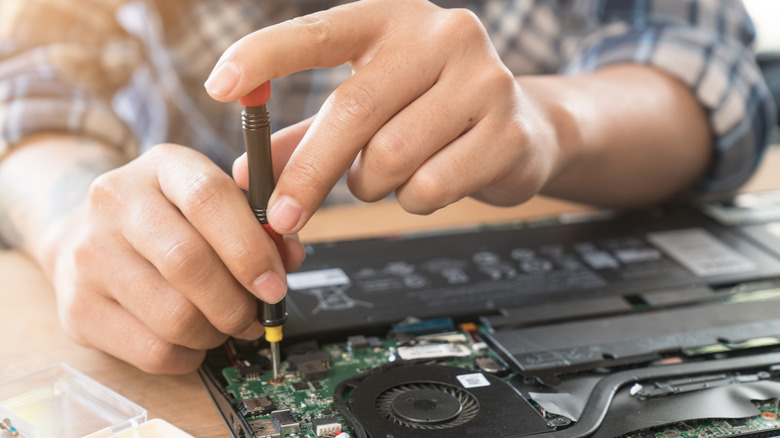Can Direct Sunlight Damage Your Laptop? Here's What You Need To Know
If you are among those who hold a remote job, you might want to make your day exciting by experimenting with different workspaces. Working outdoors can be great way to keep the inspiration flowing, especially for creative professionals. A quiet green park can make the most mundane of tasks seem exciting, however, there is a catch. Both you and your laptop might struggle under direct sunlight after prolonged exposure.
Most laptops are not designed to function under direct sunlight and may show some immediate warning signs. Frequent overheating with prolonged usage under direct sunlight can permanently degrade the battery's performance. Additionally, components such as LCD screens can wash out and make the visuals appear dull. Laptop parts may even warp under high heat, ruining the aesthetics of your machine. That said, you can still work outdoors if you are better prepared to handle the sunlight. While your sunscreen might not help, sunshades tailor-made to protect laptops from direct sun exposure can be a good option. Here's all the damage direct sunlight can cause and how to protect your laptop against it.
Sunlight can damage the internals of a laptop
Most electronics, especially the battery-powered ones don't fare well under direct sunlight. That's because overheating can permanently damage components such as batteries and processors. Most laptops use Lithium-Ion batteries that are designed to be operated under a specific temperature range. Prolonged use under direct sunlight can degrade the battery's performance and you may need the charger more frequently. In extreme cases, the battery might swell and become more vulnerable to combustion. This is the reason why your iPhone will display a temperature warning message when you leave your it in the sun for too long.
You may have also noticed the warm air coming from the fans on your laptop. These fans perform the essential task of keeping your laptop cool, as the processor and GPU can overheat on their own. Add direct sunlight to the mix, and the fans might not be able to dissipate the extra heat. In some cases, the laptop might lag due to thermal throttling or even shut down abruptly. Apart from the overheating, the UV radiation in sunlight can also be detrimental to LCD screens and the laptop body. The organic components inside an LCD display can be damaged under UV and IR radiation and may result in distorted or washed-out colors. Moreover, the non-UV resistant materials can also fade in color with prolonged UV exposure.
Using a laptop outdoors
You should avoid using your laptop under direct sunlight to avoid possible damage, however, there are some workarounds to safely work outdoors during the day. The easiest is to find a shade from a tree or other structure to keep your laptop safe. However, if you can't find one or need a permanent solution, you could opt for a laptop sunshade.
These sunshades enclose the laptop's body and stop direct sunlight from falling onto the device. Some heat resistant ones absorb the sun's heat to further keep the laptop cool. You also get the added benefit of better screen visibility as low-brightness displays can be hard to see in daylight. While these laptop accessories can improve productivity, sunshades can often look awkward and might make you conscious while in public. The ambient heat can still cause overheating despite using a sunshade and you should constantly monitor the CPU and GPU temperatures to ensure everything is cool under the hood. Additionally, a portable laptop stand for better airflow and an anti-glare screen protector can be good investments if you work outdoors frequently.


